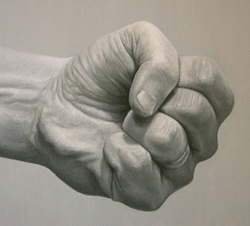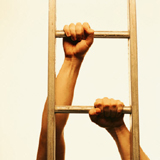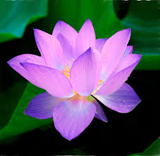Growth
Traversing attachment
Abstract
Attachment is a considerable barrier to human growth and well-being. To begin with, the only way of annulling it is to re-draw one’s life in a totally new and truer way. One then has to loosen the knot of ego. Practice of inner work, aligned to a conscious unfolding of the being, can be the means of liberation. In this context, the meaning of ‘attachment’, used ordinarily to denote a tie to a person or object, is broadened to encompass the whole range of human experience.
Introduction
Attachment can be traced at every level of human existence. It cramps and narrows the consciousness; it produces an underlying feeling of discontent. Humanity is attached to what it claims that it owns: its so-called possessions. Attachment discolours its relationships and drains its precious vitality. The hallmark is a rigidity which is inimical to all integral progress. Attachment runs so deep because man is attached to his conditioning; virtually every step he takes is manufactured by the past.
Only at the summit, with the Divine itself, does attachment have a beneficial effect on the human psyche. At this point, the rigidity dissolves into union. When the ‘pulling’ desists, a more unconditional joining evolves. This transcends all boundaries, opening the way to an endless peace, bliss and freedom. It is a supreme psychological state, a state also preparatory to the transformation of the body itself.
But every tie below points to a huge malaise. As anything moving inside affects the outside, it drains the health of the physical itself. When authentic control is surrendered to these chains, the body can become so isolated it moves by unconscious, mechanical habit. Every part of the nature shrinks from this affliction. So it is imperative that these ties be addressed if one wants to grow in consciousness. If the growth becomes integral then a happy consequence is a greater integral health.
Primitive attachments
If one is determined to traverse through attachment one has to begin at the bottom rung. There is no other way. Firstly, we address the more surface knots of our nature. There, we will find a myriad of desires, addictions and cravings which we might try to pluck out one by one from their very roots. Very soon one realises that this task is endless: the whole has to be addressed. In the initial phase, the desire for food, for sex, for ease and comfort, for possessions and money, for fame and reputation, for conquest and ambition, all these things, can be changed by one factor alone: the decision to entirely reverse the direction of one’s life. One detaches: that is the beginning. These attachments then have to be overturned, scrutinised, observed, rejected or transmuted time and time again. The process can be extremely laborious; considerable perseverance is required. But the first principal change is one of poise. The whole direction of one’s consciousness has to turn around: it has to withdraw from the surface and turn inside.
The problem, however, is that humanity is, by and large, attached to impermanence. It still insists on deriving its satisfaction from the ephemeral. This seems to me a fundamental problem of human existence. Only the Eternal can provide enduring joy. The ironic thing is that the Eternal resides inside us. We don’t have to go anywhere to find it. But we are always looking to the outside for our stability. We look at circumstances but not at the ultimate Cause behind them. There can be no enduring happiness in this. It’s like trying to build our castle with sand because with one single wave it’s all over. But when we have an inkling of what lies inside us, the pull of outer things gradually begins to wane.
So traversing attachment implies releasing the bondage to outside attractions:
“To become indifferent to the attraction of outer objects is one of the first rules of yoga, for this non-attachment liberates the inner being into peace and the true consciousness (1).”
I found that once the decision to surrender was made, the Force gradually stood forward and started to increasingly manage my life. This might take a long time but something in the being profoundly changes as a result of this shift. There are no half-measures; the process starts by stepping out of the mainstream even if the rest of society is heading in an opposite direction. If one’s upbringing and education has conformed to the social norm, there is no other choice. It’s like turning one’s life upside down and beginning all over again. Some resolve is required to make this turn. Sometimes a single circumstance is sufficient to precipitate the change. The catalyst may be often crisis or illness. That was what provided me the decisive nudge. We find the hand of Grace uses countless devices to turn the wheel of progress.
The urge for change will always be induced by an ever-growing sense of dissatisfaction. The measure of dissatisfaction indicates the necessity for change. There has to be a calling. The psychic being must be sufficiently evolved to embark on this radical new road. If one is blessed with a more conscious upbringing, there is less upheaval and the transition will be much less acute and painful. If one is brought up in a truer milieu, there may even be something like a seamless progression. Otherwise a fearless determination is required. It is better to start as soon as one feels ready because the energy required to drive this shift is immense. It is no time for procrastination; one has to make the leap.
What has to persist is a sense of resolution. Take, for example, pleasure. Society depends on pleasure. Humanity demands it. The idea that pleasure might be actually harmful, that it might stunt one’s growth, seems outrageous in commonplace circles. Man is constantly trying to stay on this merry-go-round of pleasure and it is considered a disaster if he falls off. The pain and bruising is immense. But every time one boards the carousel, there is a certainty that one will continually be thrown off until the lesson is fully absorbed. Are we willing to buck the trend? An inner resolve and poise must be maintained at all times. If one persists, the attraction of pleasure becomes increasingly pale over time.
The central knot
As one grows in consciousness, the awareness sharpens and a searchlight on attachment directs itself more below the surface. One becomes more conscious of inner movements and starts noticing these ties appearing inside. Gradually, one starts to become aware of how pervasive this affliction really is. As one observes, one sees that every strand of attachment is interconnected and can be traced to a single source. There is a central knot. In the Integral Yoga, the path of works provides the ideal platform for this understanding.
A major cause of dissatisfaction and stress in life is the attachment we hold to the outcome of our work. This has been certainly my experience and it indicates a lack of trust. The problem comes down to control: if ‘I’m not in command, what on earth will happen?’ At the bottom, the urge to control feeds on appropriation: the desire to yield the fruits of one’s labour. There is always a hidden agenda behind attachment; a sense of unfulfilled demand and egoism is invariably present. The ego is tugging our awareness down another dead-end.
So “in the path of works action is the first knot we have first to loosen (2).” The knot comes from ego and desire is what fuels the action (3). Releasing this knot can be an extremely lengthy process. It is a time of transition. The nature, once desire-less, will then be moved by something entirely new. Otherwise nothing would move at all. So up to reaching this point, of complete surrender to the Divine Force, one needs to become aware of what one is being moved by. One has to step back continuously to enquire what is going on. One acquires the art of observation. It is practice but ideally it is practice that should become ‘everyday life’. In time, through this work, one acquires the ability to distinguish wrong movements from right. In time, any wrong movement will produce a feeling of unpleasantness, a sense of uneasiness or friction. When a wrong movement is initiated, it is as if something foreign is jarring the consciousness. The knowledge of this wrong movement brings true change. There is a spontaneous resonance in the knowing; it turns the darkness into light and automatically transforms wrong into right. When it descends it brings such a feeling of security and peace.
Gradually too, as the sādhanā unfolds and as one begins to surrender and open, one becomes aware of a presiding support and presence behind the play. We become conscious of the Power that has brought us exactly to where we are. Slowly we realise the source of our inner gaze, the supreme factor behind all meaningful enquiry and observation. The hand of the soul may appear in unexpected glimpses but over time it instils a more balanced, peaceful and harmonious setting to the contrasts of our nature. Indeed, once given the necessary collaboration, the psychic influence will slowly but surely begin to transform it. We then come to understand this influence as the truest agent of knowledge. It provides the definitive seal of the Truth.
The changes may be piecemeal at first but they are markers of true progress. We may lapse and stumble occasionally in between but these steps become foothills to a greater equality established through the spirit. From then, the Force begins to act increasingly on the more equal nature. The important thing is, once the consciousness is sufficiently and broadly awake, the whole gets addressed. The Force increasingly intercedes and starts to master our actions. Slowly, the central knot is loosened and attachment eventually wanes and diminishes. Traversing attachment doesn’t necessarily have to be a struggle; it is usually a very long journey but it can always be a joy.
Human relationships
“Human beings are in the habit of basing their relationships with others on physical, vital and mental contacts; that is why there is almost always discord and suffering. If, on the contrary, they based their relationships on psychic contacts (between soul and soul), they would find that behind the troubled appearances there is a profound and lasting harmony which can express itself in all the activities of life and cause disorder and suffering to be replaced by peace and bliss (4).”
The vast majority of relationships that humanity weaves are built on trade. Even with the most revered and engrained of relationships, like those of blood, we are expected to behave in a certain way to fulfil a desire for conformity. Once we step out of line, the trade breaks down and anguish results. As long as the bargain is being met and each person makes the other ‘feel good’ the pattern continues. Man is attached to the ‘return’. He likes to feel important; he enjoys being reminded that he makes a difference. It is a basic vital craving which can manifest in even the most subtle of ways. Inevitably though, the cycle breaks down and it is surely a grace for our learning and growth when this happens. Although the immediate consequence of breakdown is one of dissatisfaction, it is an opportunity although the occasion usually serves for most to try to glue together the pieces again. Humanity is attached to such artificial solutions because its happiness is still based on little more than egoism.
Some people are preoccupied with ‘elevating’ themselves yet ignore the character of relationships they create in the outside world. It is an obvious dichotomy. If our consciousness is soaring why shouldn’t our relationships follow suit? An essential quality of non-attachment within a relationship is that of psychic disinterestedness. That necessity can surely apply to every relationship we build, not just those selected from a chosen few. If the psychic is coming forward into our lives, it can always be invited into every interchange and discourse we share. The psychic influence needs to spread by contagion: the New Dawn demands it.
As long as we conform to a stereotype, we prolong the attachment even if we might dull the sense of pain. It can be truly a suffocating experience. It is a problem that confronts many of those who cut their moorings in order to embark on a more meaningful life. The decision to break free is often met with bitterness and disbelief. Acquiring this sense of true freedom is no mean feat. One might remove oneself physically of one’s origins but sooner or later one may become conscious of an invisible cord, stretching many miles, tying one down to those same old patterns. Furthermore, for a very long time, there is bound to be resonance in what one rejects. From my experience, only love can dissolve these rigid forms. However, our natures over time have been cast into repeated grooves. One cannot break free of one’s conditioning overnight and this is probably the most pernicious attachment of them all.
Conditioning is what gives attachment its enduring strength. Over time, many of these patterns and expectations become engrained in our subconscious and lay the deepest roots. Unseen, old movements of attachment will keep reappearing at the surface. They will tend to show their face at unexpected moments when the guard is down. We need to be very awake if these patterns are to be addressed.
However, I have found that with detailed observation, these bindings become more prominent to my awareness. If at least a little psychic influence is present, I may feel these distortions appearing on the body. When they surface, the usual consequence is one of discomfort or pain. It has to be experienced but observed in a disinterested way. There is a way of connecting the Truth inside with what is being observed. The fusion immediately brings a knowing which simultaneously resolves. It is a supremely liberating experience.
Practice certainly helps but there needs to be also a natural and conscious unfolding accompanying it. The two work very well together. The process starts by keeping the waking parts of our nature as alive and conscious as possible. The influence and light of the higher parts will eventually percolate down to the lower regions, including the subconscious:
“When the higher consciousness is once established in the waking parts, it goes down into the subconscient and changes that also, makes a bedrock of itself there also (5).”
Meanwhile, the process of enquiry and observation serves well if brought into daily life. In truth, the work represents a non-stop, continual process.
The only solution
The only solution is to align oneself with this Truth and Light always. The difficulty of attachment can never be looked upon in isolation. Its central support lies buried deep within the folds of our nature. We begin by turning around the course of our life. We look for the Eternal not the ephemeral. We absorb the Mother’s words:
“It is not the universe you see: it is yourself you see in the universe (6).”
It is only by dissolving the knot of ego that attachment be completely annulled. This is the penultimate stage in the evolution of human consciousness. Only transformation lies beyond. So we have to clear ourselves of the prison-house of ego. The Light is our answer always:
“To catch each thing that should not be done, catch it like that, and then hold it firmly in front of the light until the light can act upon it to transform it: this is a work one can do all the time. No matter what one is doing, one can always do this work. Each time one becomes aware that there is something which is not all right, one must catch it like this, prevent it from hiding, for it tries to hide: catch it and then keep it like this before the light of one’s conscious will, and then put the light upon it so that it changes (7).”
References
1. Sri Aurobindo. Birth Centenary Library, Volume 23. Pondicherry: Sri Aurobindo Ashram Trust; 1970, p. 661.
2. Sri Aurobindo. SABCL, Volume 20. Pondicherry: Sri Aurobindo Ashram Trust; 1971, p. 94.
3. The Mother. Collected Works of the Mother, Volume 8. 2nd ed. Pondicherry: Sri Aurobindo Ashram Trust; 2003, p. 70.
4. The Mother. Collected Works, Volume 10. 2002, p. 246.
5. Sri Aurobindo. SABCL, Volume 22. 1970, p. 360.
6. The Mother. Collected Works, Volume 6. 2003, p.136.
7. The Mother. Collected Works, Volume 7. 2003, p. 75.
James Anderson is a member of SAIIIHR and coordinating editor of NAMAH
Share with us (Comments,contributions,opinions)
When reproducing this feature, please credit NAMAH,and give the byline. Please send us cuttings.







